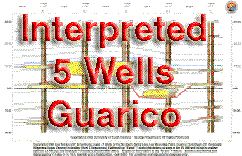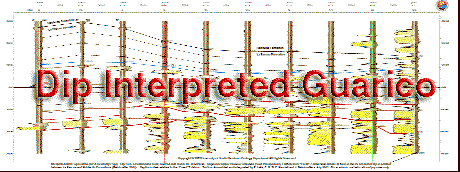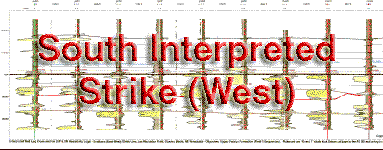|
WELL
LOG EXERCISE SOLUTIONS
You can find our solutions
to the well exercises below. Though we are happy with these solutions,
or they would not be posted on the site, you should recognize that
these solutions also represent matters of opinion that are based
on the models we have chosen to build our interpretations from;
remember "beauty is in the eye of the beholder"
and not neccessarily the ultimate "truth"!
We also created a movie
showing the evolution of a clastic sequence with incised valley
fill utilizing the well logs used in these exercises. (you will
need to have a QuickTime movie player in order to view the movie).
Click on image to view the movie and use the left and right arrows
on the keyboard to move backward and forward throught the movie
(click
here for a smaller-version). This movie gives a sense of the
geological reasoning behind the well log interpretations that have
been provided.

EXERCISE
1 Solution
- A segmented
.pdf image of the cross-section with the solution to
Exercise 1 can be printed, assembled and taped (PRINT-a-EX1-X-SEC).
- A complete .pdf
image of the cross-section with the solution to Exercise 1 that
can be printed as one image or segmented (PRINT-b-EX1-X-SEC).
- You can also view
the solution file as a .jpg image (VIEW-EX1-X-SEC).
- All the well logs
(from left to right W-1, W-2, W-3) were placed side-by-side and
aligned with the top correlation marker (dotted line at the top
of each well log).
- For each of the SP
curves (the right trace) the areas of the curve with the "0" or
low SP values are inferred to represent shale, while high SP values
are inferred to represent sand, i.e. those values further from
center line.
- The adjacent well
logs are correlated on the basis of similarly shaped curves, by
drawing a boundary surface under each correlatable interval.
- On each of the well
logs shale is colored green and sand yellow.
- You can review the
data sheet sheet at the bottom of the x-section solution file
for more precise values.
EXERCISE
2 Solution
- A .pdf
image of the cross-section representing the solution to Exercise
2 can be printed, assembled and taped (PRINT-A-EX2-X-SEC).
- A complete .pdf
image of the cross-section with the solution to Exercise 2 that
can be printed as one image or segmented (PRINT-B-EX2-X-SEC).
- You can also view
the solution file as a .jpg image (VIEW-EX2-X-SEC).
- All the well logs
(from left to right W-1, W-2, W-3, etc.) were placed side-by-side
and aligned with the top correlation marker (dotted line at the
top of each well log).
- For each of the SP
curves (the right trace) the areas of the curve with the "0" or
low SP values are inferred to represent shale, while high SP values
are inferred to represent sand, i.e. those values further from
center line.
- On each of the well
logs shale is colored green and sand yellow.
- The adjacent well
logs are correlated on the basis of similarly shaped curves, by
drawing a boundary surface under each correlatable interval.
- The cross-section
is divided into parasequences and the system tracts are identified
within each parasequence.
- The transgressive
surfaces were indentified first. These surfaces coincide with
thin intervals of winnowed sediment that are produced as the sea
transgresses across the underlying sediments. Thus the inferred
transgressive surfaces are thin intervals that show a slight increase
in grain size over thin shale intervals that may in turn overlie
blocky sands. The transgressive surface is often indicated on
the SP by an increase in grain size and a coincidental local increase
in resistivity which matches carbonate cementation.
- The Maximum Flooding
Surfaces (mfs's) of each parasequence was interpreted next. On
the well logs these surfaces are interpreted to coincide with
the occurrence of shale (kicks on the logs with the lowest SP
values) just beneath sections that coarsen upward (i.e., the SP
values increase, exhibiting a vertical funnel shape on the SP
log). Three parasequences (each parasequence being enveloped
by mfs) were identified and were labelled from the base up as
A, B, and C.
- The sequence boundary
(SB) on the cross-sections was the final surface identified. This
was picked at the base of the channel sands (incised valley fill).
A massive boxcar trend in log character was inferred to represent
the channel fill of incised valleys and this fill was correlated
to adjacent well logs.
- For each parasequence
the total sand content in feet (utilize the middle log scale)
was estimated while utilizing the middle of the log to mark sand
body boundaries and triangles to record changes in grain size
within each parasequence). The values were recorded in a spreadsheet.
- Based on the mfs surfaces
and the identified channels, the systems tracts for each of the
well logs (LST, TST, and HST) were identified. Channel sands
were interpreted to represent a Lowstand Systems Tract which was
incised into the underlying Highstand Systems Tract, and is overlain
by Transgressive System Tract deposits. Where no channels were
present, the mfs were utitilized to identify the HST (the deposits
above the mfs) and the TST (the deposits below the mfs).
- The final step should
be to write up an analysis describing your conclusions based on
your interpretation of the depositional setting and the evolution
of each parasequence.
- You can review the
data sheet sheet at the bottom of the x-section solution file
for more precise values.
EXERCISE
3 Solution
- Three .pdf
images of the cross-sections represeting the solution to this
exercise can be printed, assembled and taped (PRINT-X-SEC-A,
PRINT-X-SEC-B,
PRINT-X-SEC-C).
- You can also view
and /or print the solution files as .jpg images
(VIEW-X-SEC-A,
VIEW-X-SEC-B,VIEW-X-SEC-C).
- Three well cross-sections
were created: two parallel to strike and the third in the dip
direction (see base map). The sequence stratigraphy of the sediments
in the sections was interpreted using the cross-sections and the
associated maps you created should illustrate your interpretations.
- All the well logs
(from left to right W-1, W-2, W-3, etc.) were placed side-by-side
and aligned with the top correlation marker (dotted line at the
top of each well log).
- For each of the SP
curves (the right trace) the areas of the curve with the "0" or
low SP values are inferred to represent shale, while high SP values
are inferred to represent sand, i.e. those values further from
center line.
- On each of the well
logs shale is colored green and sand yellow.
- The adjacent well
logs are correlated on the basis of similarly shaped curves, by
drawing a boundary surface under each correlatable interval.
- The cross-section
is divided into parasequences and the system tracts are identified
within each parasequence. The Maximum Flooding Surfaces (mfs's)
of each parasequence was identified first. On the well logs these
surfaces are interpreted to coincide with the occurrence of shale
(kicks on the logs with the lowest SP values) just beneath sections
that coarsen upward (i.e., the SP values increase, exhibiting
a vertical funnel shape on the SP log). Three parasequences (each
parasequence being enveloped by mfs) were identified and were
labelled from the base up as A, B, and C.
- The transgressive
surfaces were indentified next. These surfaces coincide with
thin intervals of winnowed sediment that are produced as the sea
transgresses across the underlying sediments. Thus the inferred
transgressive surfaces are thin intervals that show a slight increase
in grain size over thin shale intervals that may in turn overlie
blocky sands. The transgressive surface is often indicated on
the SP by an increase in grain size and a coincidental local increase
in resistivity which matches carbonate cementation.
- The sequence boundaries
(SB) on the cross-sections were the final surfaces identified. These
were picked at the base of the channel sands (incised valley fill).
A massive boxcar trend in log character was inferred to represent
the channel fill of incised valleys and this fill was correlated
to adjacent well logs.
- For each parasequence
the total sand content in feet (utilize the middle log scale)
was estimated while utilizing the middle of the log to mark sand
body boundaries and triangles to record changes in grain size
within each parasequence). The values were recorded in the spreadsheet.
- Based on the mfs surfaces
and the identified channels, the systems tracts for each of the
well logs (LST, TST, and HST) were identified. Channel sands
were interpreted to represent a Lowstand Systems Tract which was
incised into the underlying Highstand Systems Tract, and is overlain
by Transgressive System Tract deposits. Where no channels were
present, the mfs were utitilized to identify the HST (the deposits
above the mfs) and the TST (the deposits below the mfs).
- The final step should
be to write up an analysis describing your conclusions based on
your interpretation of the depositional setting, the evolution
of each parasequence and the sand isopach maps.
- You can review the
data sheet sheet at the bottom of each x-section solution file
for more precise values.
EXERCISE
4 Solution
- A cross-section representing
a potential solution to this exercise can be viewed on the .pdf
file that can be accesses via the thumbnail and/or the.gif
file from the link provided below. This solution to this exercise
can be printed from either the .pdf and .jpg figures provided.

- As an alternative
the above .pdf file this cross section can also be viewed by clicking
on the link to a large .jpg file of the 5
Well Section Interpreted which provides the same solution
to this exercise seen on the .pdf file.
- For each of the SP
curves (the right trace) the areas of the curve with the "0" or
low SP values are inferred to represent shale, while high SP values
are inferred to represent sand, i.e. those values further from
center line.
- On each of the well
logs shale is now colored brown and sand yellow.
- The adjacent well
logs are correlated on the basis of similarly shaped curves, by
drawing a boundary surface under each correlatable interval.
- The cross-section
is divided into parasequences and the system tracts are identified
within each parasequence.
- The Transgressive
Surfaces (TSs) of each parasequence was identified first. These
surfaces coincide with thin intervals of winnowed sediment that
are produced as the sea transgresses across the underlying sediments.
Thus the inferred transgressive surfaces are thin intervals that
show a slight increase in grain size over thin shale intervals
that may in turn overlie blocky sands. The transgressive surface
is often indicated on the SP by an increase in grain size and
a coincidental local increase in resistivity which matches carbonate
cementation.
- The Maximum Flooding
Surfaces (mfs's) of were identified next. On the well logs these
surfaces are inferred to coincide with the occurrence of shale
(kicks on the logs with the lowest SP values) just beneath sections
that coarsen upward (i.e., the SP values increase, exhibiting
a vertical funnel shape on the SP log). Three parasequences (each
parasequence being enveloped by mfs) were identified and were
labelled from the base up as A, B, and C.
- The sequence boundaries
(SB) on the cross-sections were the final surfaces identified. These
were picked at the base of the channel sands (incised valley fill).
A massive boxcar trend in log character was inferred to represent
the channel fill of incised valleys and this fill was correlated
to adjacent well logs.
- For each parasequence
the total sand content in feet (utilize the middle log scale)
was estimated while utilizing the middle of the log to mark sand
body boundaries and triangles to record changes in grain size
within each parasequence). The values were recorded in the spreadsheet.
- Based on the mfs surfaces
and the identified channels, the systems tracts for each of the
well logs (LST, TST, and HST) were identified. Channel sands
were interpreted to represent a Lowstand Systems Tract which was
incised into the underlying Highstand Systems Tract, and is overlain
by Transgressive System Tract deposits. Where no channels were
present, the mfs were utitilized to identify the HST (the deposits
above the mfs) and the TST (the deposits below the mfs).
EXERCISE
5 Solution
- Cross-sections of
the interpreted North-South Dip line, and the two strike lines
represented by a Northern Strike Line (split into an Eastern section
and a Western Section) and a Southern Strike Line (split into
an Eastern section and a Western Section) are provided as potential
solutions to this exercise with .pdf files that
can be accesses via the thumbnails and .gif or .jpg files from
the links provided below. These solutions to the exercises can
be printed from either the .pdf, .gif or .jpg images of the figures
provided.
 |
| As an alternative
this cross section can also be viewed as a large .gif
file by clicking on the North-South
Dip line |
.gif) |
| As an alternative
this cross section can also be viewed as a large .jpg
file by clicking on the South Eastern
Section |
.gif) |
| As an alternative
this cross section can also be viewed as a large .gif
file by clicking on the South Western
Section |
.gif) |
| As an alternative
this cross section can also be viewed as a large .gif
file by clicking on the South Eastern
Section |
 |
| As an alternative
this cross section can also be viewed as a large .gif
file by clicking on the South Western
Section |
- For each of the SP
curves (the right trace) the areas of the curve with the "0" or
low SP values are inferred to represent shale, while high SP values
are inferred to represent sand, i.e. those values further from
center line.
- On each of the well
logs shale is now colored brown and sand yellow.
- The adjacent well
logs are correlated on the basis of similarly shaped curves, by
drawing a boundary surface under each correlatable interval.
- The cross-section
is divided into parasequences and the system tracts are identified
within each parasequence.
- The Transgressive
Surfaces (TSs) of each parasequence was identified first. These
surfaces coincide with thin intervals of winnowed sediment that
are produced as the sea transgresses across the underlying sediments.
Thus the inferred transgressive surfaces are thin intervals that
show a slight increase in grain size over thin shale intervals
that may in turn overlie blocky sands. The transgressive surface
is often indicated on the SP by an increase in grain size and
a coincidental local increase in resistivity which matches carbonate
cementation.
- The Maximum Flooding
Surfaces (mfs's) of were identified next. On the well logs these
surfaces are inferred to coincide with the occurrence of shale
(kicks on the logs with the lowest SP values) just beneath sections
that coarsen upward (i.e., the SP values increase, exhibiting
a vertical funnel shape on the SP log). Three parasequences (each
parasequence being enveloped by mfs) were identified and were
labelled from the base up as A, B, and C.
- The sequence boundaries
(SB) on the cross-sections were the final surfaces identified. These
were picked at the base of the channel sands (incised valley fill).
A massive boxcar trend in log character was inferred to represent
the channel fill of incised valleys and this fill was correlated
to adjacent well logs.
- For each parasequence
the total sand content in feet (utilize the middle log scale)
was estimated while utilizing the middle of the log to mark sand
body boundaries and triangles to record changes in grain size
within each parasequence). The values were recorded in the spreadsheet.
- Based on the mfs surfaces
and the identified channels, the systems tracts for each of the
well logs (LST, TST, and HST) were identified. Channel sands
were interpreted to represent a Lowstand Systems Tract which was
incised into the underlying Highstand Systems Tract, and is overlain
by Transgressive System Tract deposits. Where no channels were
present, the mfs were utitilized to identify the HST (the deposits
above the mfs) and the TST (the deposits below the mfs).
- The final step should
be to write up an analysis describing your conclusions based on
your interpretation of the depositional setting, the evolution
of each parasequence and the sand isopach maps..
|




.gif)
.gif)
.gif)
